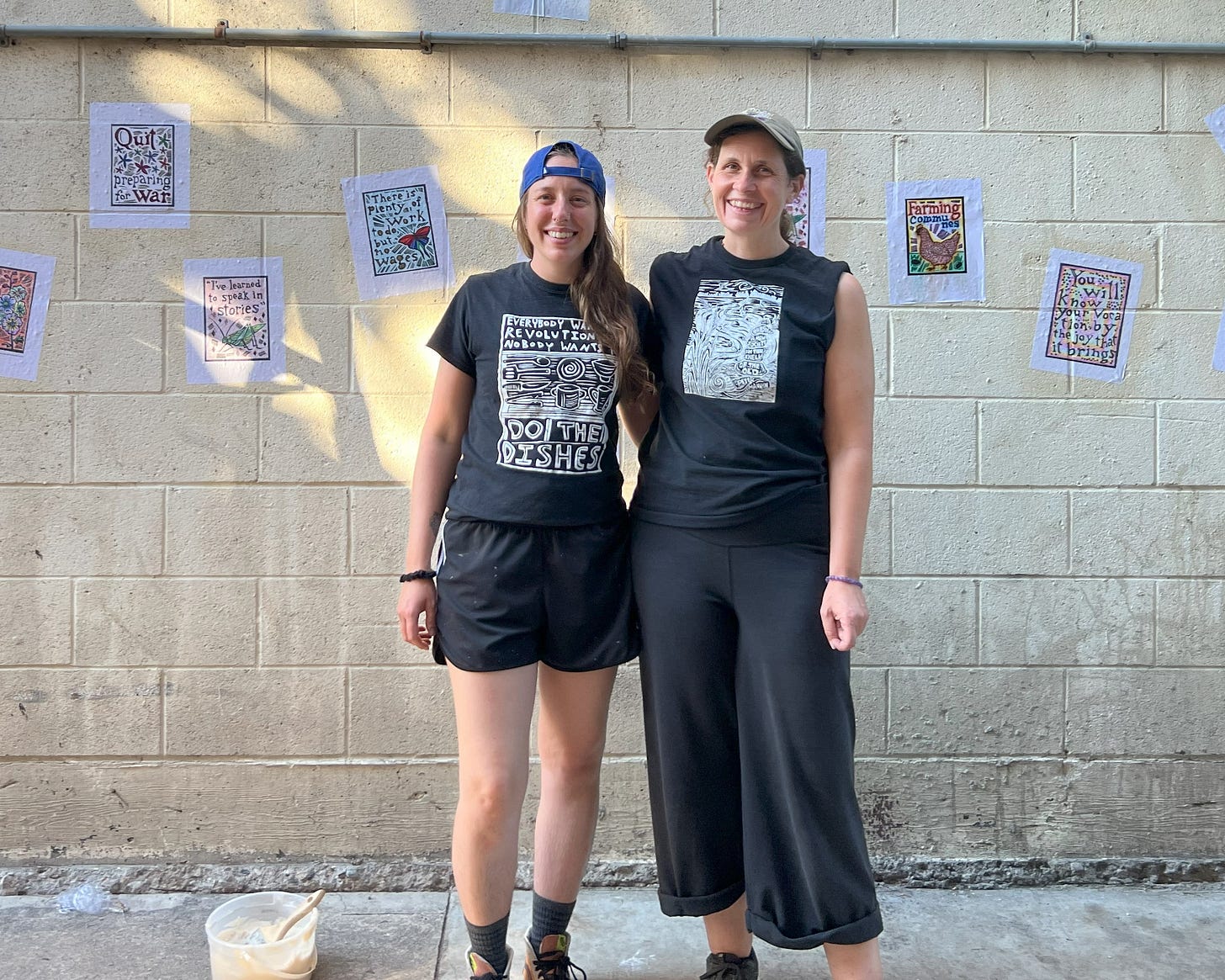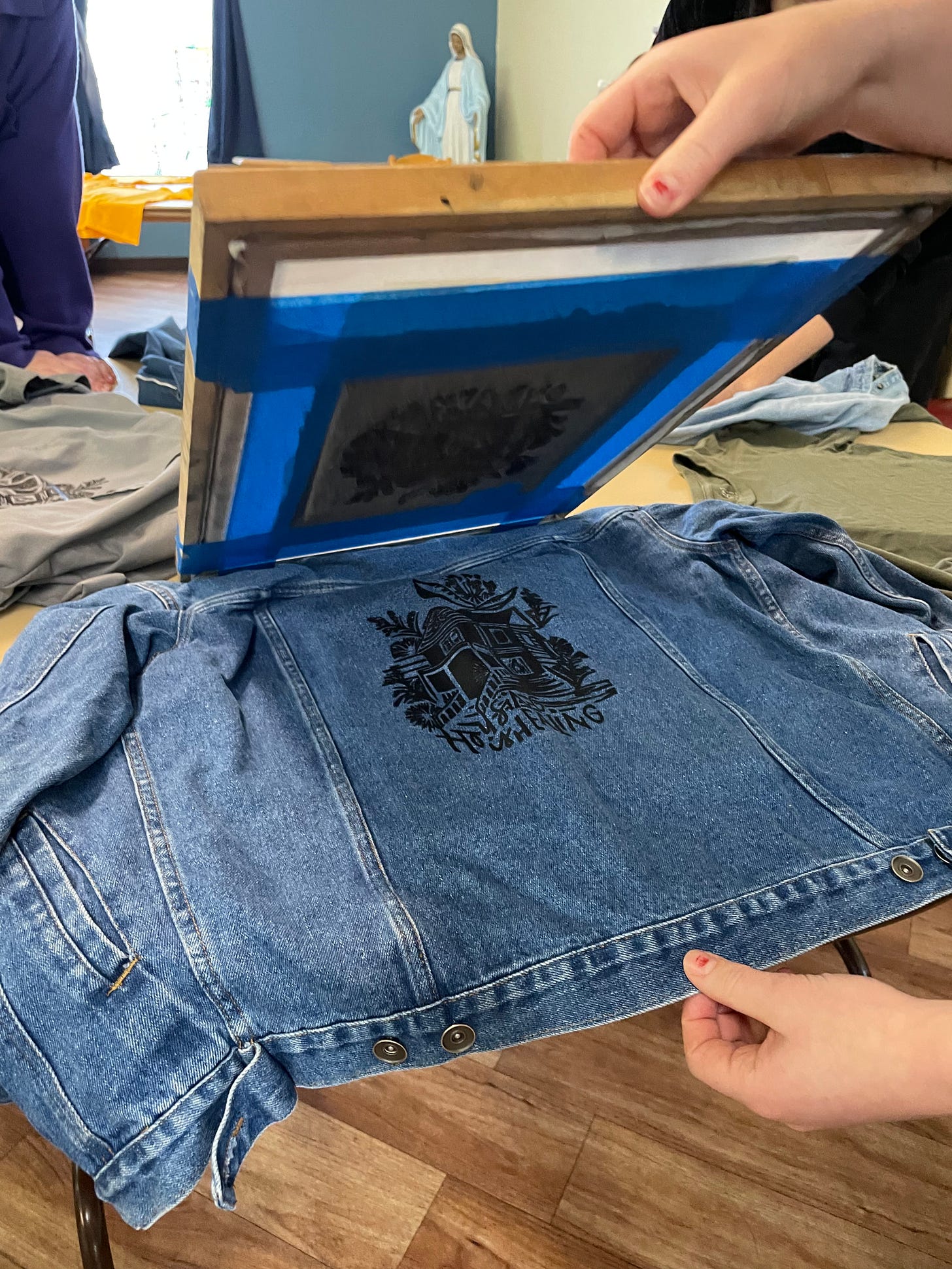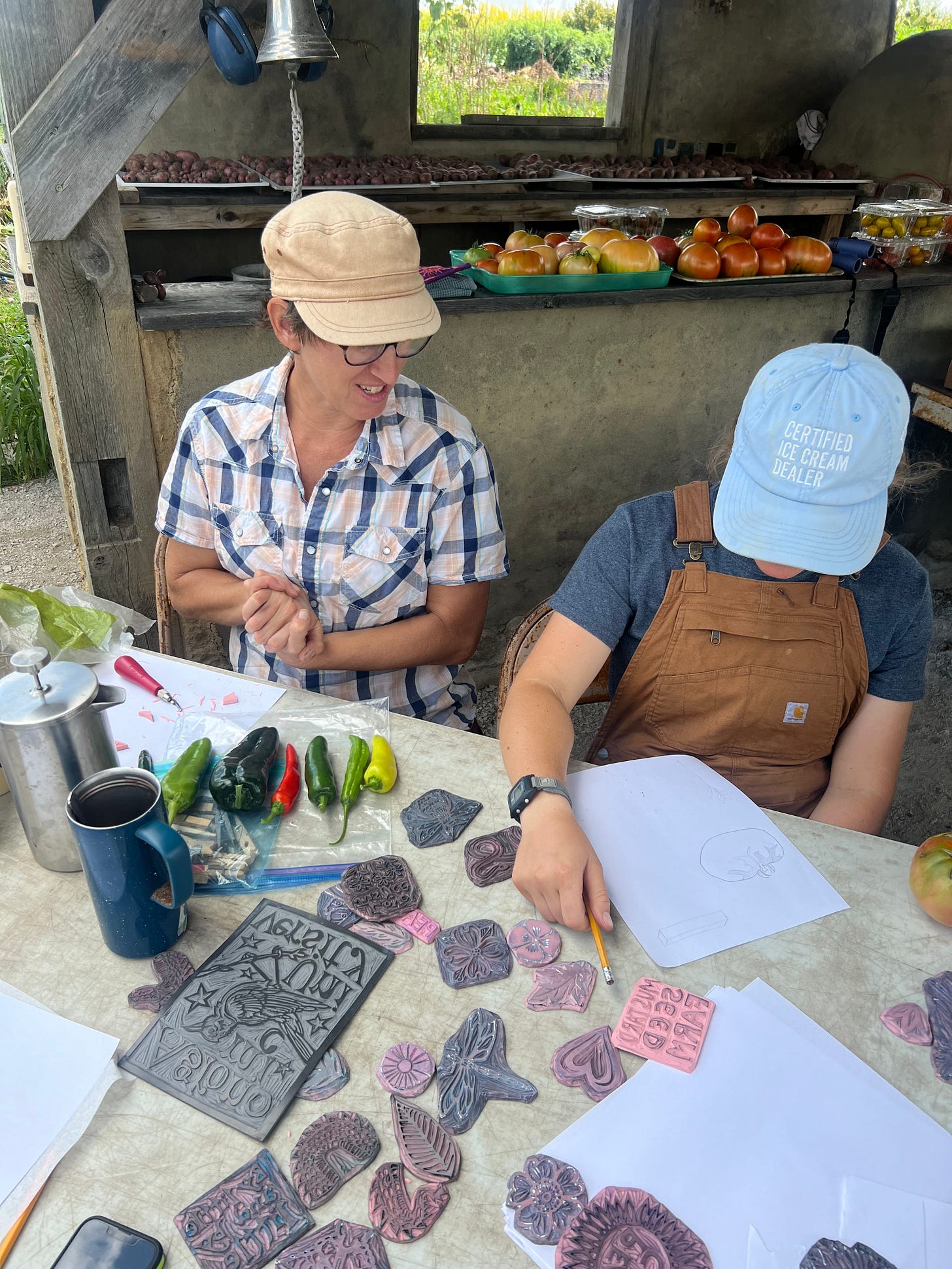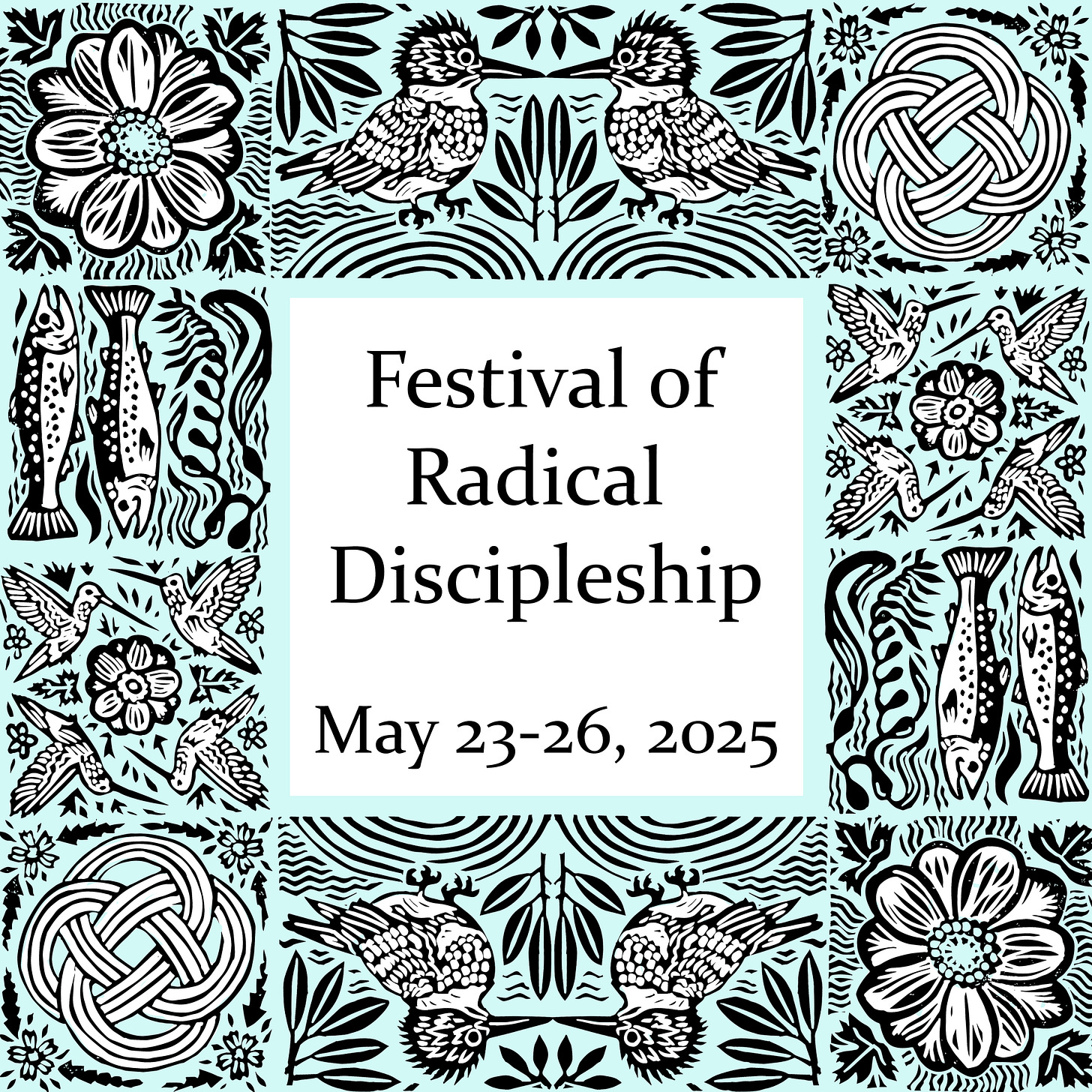The Illuminator on Building Community Around Art
Surprise! We said we weren't posting this week due to the holiday...but then we saw the latest issue of The Illuminator, the CW arts zine. Here's a preview.

As we mentioned last week, we are taking the week off because everyone on our team will be traveling and with family for most of the week. However, shortly after we sent out the last issue of the Roundtable newsletter, the latest issue of The Illuminator came out. As you may already know, this is the Catholic Worker arts magazine put out occasionally by Becky McIntyre and Sarah Fuller. Both the writing and the art are consistently excellent, and I would urge you to subscribe if you haven't already. Below we offer a teaser preview of each article; if you see something of interest, click through to The Illuminator, then subscribe.
Also, we have the first of the Advent reflections written by Dorothy Day for Ave Maria magazine in 1966. We’ll continue to run these reflections throughout Advent in the Sunday edition of Roundtable.
—Jerry
Creating Community Around Catholic Worker Art
Welcome to the the third issue of The Illuminator, a newsletter about arts and artists in the Catholic Worker movement
We write to you hoping to share some beauty and light, wherever this newsletter may find you. Whether you are despairing or celebrating, we can all relate to Dorothy Day’s words:
“But the final word is love. At times it has been, in the words of Father Zossima, a harsh and dreadful thing, and our very faith in love has been tried through fire. We cannot love God unless we love each other, and to love we must know each other. We know him in the breaking of bread, and we are not alone any more. Heaven is a banquet and life is a banquet, too, even with a crust, where there is companionship. We have all known the long loneliness and we have learned that the only solution is love and that love comes with community.”
In this issue we highlight South Bend Catholic Worker artist Rachel Mills who is making art to highlight the needs of her community. We give an update on the work we did this summer at the Los Angeles Catholic Worker and at Mustard Seed Community Farm in Ames, Iowa, and share some poetry from friends. Sarah offers her thoughts on Jeffry Korgen and Christopher Cardinale’s new graphic novel, “Dorothy Day: Radical Devotion.” And finally, we share some upcoming events that we are doing together in 2026. Maybe these glimpses can be some inspiration for the road ahead.
November Featured Artist: Rachel Mills
By: Becky McIntyre
In this article, you’ll meet Rachel Mills, a printmaker living and working at the St. Peter Claver Catholic Worker House in South Bend. Discover how Rachel's art practice intertwines with her commitment to community, hospitality, and social justice. Learn how her journey began with creating thank you cards and evolved into screen-printed t-shirts for advocacy and even a refurbished vending machine dispensing art! Explore the unique ways Rachel uses her art to engage with daily life, foster deeper connections, and invite others to participate in creative expression.
Becky & Sarah Summer/Fall Updates
By: Sarah Fuller
This article is about Becky and Sarah's summer and fall adventures in the world of Catholic Worker art! From wheat-pasting art in the alleyway of the Los Angeles Catholic Worker’s Hippie Kitchen to carving linoleum blocks at Mustard Seed Community Farm in Iowa, they've been busy creating, collaborating, and exploring the intersection of art, community, and social justice. Discover the inspiration they found in legendary printmakers like Dürer and Goya, and learn how they shared their passion for art with others through workshops and discussions.
“When we rely solely on facts and figures in arguing for change, this automatically puts people on the defensive, especially if it threatens their worldview. This is why I believe it is the Arts of all kinds that have the power to break through this hold of the dominant narrative and free our people in order to embrace a new worldview. And this is because I think the arts have a way of bypassing the argumentative impulse that rises in resistance to facts and figures and reasoned analysis by creating a space where something new can happen. What this means is that we need poets as much as we need policy wonks. We need compelling stories of human drama as much as we need clear economic and social analysis. We need music and art that can touch the soul and open the mind in ways that reasoned analysis could never touch. We need to be lyrical as well as logical.”
—Tom Cordaro
Graphic Novel Reflection
By: Sarah Fuller
Sarah Fuller reflects on the new graphic novel, Dorothy Day: Radical Devotion, sharing her own personal journey with Dorothy Day's writings and the complexities of retelling the story of such an influential figure. This piece examines the graphic novel's portrayal of key moments in Day's life, the intricacies of her legacy within the Catholic Worker movement, and the enduring power of her commitment to social justice and creative expression.
Our Upcoming Events in 2025
Tuesdays with Merton
International Thomas Merton Society
Merton as Visual Artist and Creating Socially Conscious Art in the 21st Century
April 8, 2025, 7 PM. EST
Becky McIntyre and Sarah Fuller will discuss their art and experiences as artists working in religious and social justice movements, particularly the Catholic Worker movement. They will discuss intersections of faith, resistance, creativity and justice in their own life histories and artistic practices. They will show and discuss examples of their art, and discuss ways in which the art and work of Thomas Merton touches on their own artistic practices.
Second Festival of Radical Discipleship
Bartimaeus Kinsler Institute 2025
“We are thrilled that our friends at Kirkridge Retreat Center in northeast Pennsylvania will host this “reunion” ten years after our first Festival in California, and 25 years after the birth of Word & World. BCM staff will co-curate/produce/facilitate this celebration of art, music, gospel, community, and justice.”
We are helping to facilitate the art portion of the weekend!
Connect with Sarah and Becky
The Illuminator Archives | Connect by email: theilluminatorcw@gmail.com | Subscribe to The Illuminator | Sign up for Sarah’s Art Newsletter | Sign up for Becky’s Art Newsletter
WORDS FROM THE ELDERS
Reflections for Advent
Week One: Searching for Christ
by Dorothy Day in Ave Maria magazine, November 26, 1966
IT is hard to write these days because we are suffering from an embarrassment of riches in this time of renewal of the Church in the modern world. New translations of Scripture abound. In reading over Paul’s Epistle to the Galatians, which carries a subhead, “Faith and Freedom,” in the New English Bible published by the Oxford and Cambridge Universities Presses, I saw again how applicable it was for our own day.
The turbulence in the Church today is a result of a newfound, newly realized emphasis on the liberty of Christ, and the realization too that we have scarcely begun to be Christian, to deserve the name Christian.
Everything said or written is challenged, new meanings and insights are sought and found in the counsels of poverty, chastity and obedience; there is a new morality and a new theology.
Old customs are being tossed aside as meaningless or offensive to others, in our deep desire for unity with our brothers of another faith, or of no faith at all.
Old and beautiful prayers of the Mass may be meaningless one Sunday and suddenly strike you between the eyes on another. A prayer which stands out to your understanding and wraps itself around your heart with a warm comfort or pierces it with new meaning is suddenly dropped out and lost. And the accent on hearing the word instead of reading It sometimes means that you neither hear nor read it because the celebrant has a cold in the head or the congregation coughs too much, or the celebrant races along at breakneck speed through the familiar words, and again they are lost to the congregation. I keep taking my missal along to Mass in case. Anyway, for me to take it in with the eyes as well as the ears makes a double impression on the mind.
And now even the prayer, the Hail Mary, has been left out of the listing of Catholic prayers from the new Dutch catechism, so we are told in our diocesan paper.
After reading this I changed my mind about writing about the counsels for this first of an Advent series and decided to write about the Blessed Mother instead. She is, of course, a controversial figure, the last thing in the world she would want to be.
It is fitting to write about her in Advent, and I would like to tell in simple fashion about Mary in my life.
WHEN I was a very little child, perhaps not more than six, I used to have recurrent nightmares of a great God, King of heaven and earth which encompassed all, stretched out over all of us in a most impersonal way, and with this nightmare came also a great noise like that made by a galloping horseman which increased in volume until the sound filled all the earth. It was a terrifying dream and when I called out, my mother used to come and sit by the bedside and hold my hand and talk to me until I fell asleep. That passed, and then a few years later I met a little girl by the name of Mary Harrington who told me about the Blessed Mother and a heaven peopled with saints, and this also was a great comfort to me.
Years passed and I attended high school and college and then went to work for the Socialist and Communist movements in the early 20’s. Nevertheless, I often dropped into churches. One winter when I was working in New Orleans and living across the street from the cathedral there I found great joy in attending Benediction. That Christmas a Communist friend gave me a rosary. “You were always dropping into the cathedral,” she explained.
I did not know how to say the prayers but I kept it by me. I did not know any Catholics and would have been afraid to approach a priest or nun, for fear of their reading into such an approach some expectation which was not there.
A year or so later my friend, Peggy Cowley, as she was then, gave me a tiny statue of the Virgin, pale blue and white with hair like golden noodles and a gold wire halo around her head. It came from Czechoslovakia and some friend had brought it to her. She asked in exchange for it a fan my brother had sent me from Riga.
Later, it was my own motherhood which finally brought me into the Church, the joy and thankfulness I felt at tile birth of a child. I had to thank God. I felt the need of worship, so Sister Aloysia of the Sisters of Charity who lived at St. Joseph’s by the Sea, on Staten Island, taught me my prayers and my catechism and I became a Catholic. I had known before, as I am sure many children do, the Our Father and the psalms as prayers and I had heard the canticles sung in the Episcopalian Church where I had been baptized at the age of 12. But the Hail Mary and the Salve Regina and the Memorare were new to me. I was soon introduced to the Little Office of the Blessed Virgin, from which children used to be taught to read in the Middle Ages, and the versicles and hymns became part of my prayer life from then on.
Certainly it was the need to adore, to worship God that led me to religion. A sense of joy and thankfulness and exaltation made me want to raise my arms aloft to the sky and with my whole being praise the Lord. As Charles do Foucauld learned to worship by observing the religious worship of the Arabs, I had learned something of worship from observing the lives of the Jews on the East Side, where I had always lived when I was in New York. The very delicatessen reeked of prayer when I went there in the morning to buy fresh rolls and found the aged Jew alone in his shop with his phylacteries and his skull cap, his psalms before him, standing before his Lord offering up a morning prayer.
God was our Father, so I could approach Him, daring to say, Our Father. But it was reading of Jesus Christ in the New Testament that made me want to put off the old mail and put on Christ, as St. Paul said. And who had given me our Lord but the Virgin Mary? It was easy to pray to her, repetitious though it might seem. Saying tire rosary as I did so often, I felt that I was praying with the people of God, who held on to the physical act of the rosary as to a lifeline, a very present help in time of trouble. Franz Werfel said of an old woman that she told her beads as though she were knitting garments for the poor.
AS A woman I appreciated the physical aspects of prayer. All the senses of the body were engaged in the worship of the Church, the eyes through color and stained glass and statue and ikon, rich vestments, jewels, sparkling lights, candles, the smell of incense and beeswax, the sound of music, psaltery and harp and all the other instruments listed, the taste through the reception of the Body of Christ in the Host and last of all, the touch through the fingering of the beads.
“Pray without ceasing,” St. Paul wrote, and here was one way to pray without ceasing. What if there was repetition and the mind wandered? It could always be drawn back through remembering the mysteries, the joyful, the sorrowful and the glorious. (I never think of the Visitation to Elizabeth without thinking of some pregnant woman who needs our prayers.) In fact, I never think of the rosary itself as a whole without thinking of Father Farina’s talks to married couples, the joyful mysteries reflecting not only the honeymoon aspect of human love but the joys of marriage, then the sorrowful mysteries which are a part of every life and finally the glorious, achieved through fidelity and perseverance, the supernaturalizing of human love, the lifting of it above the human plane so that it becomes “a joy which no man can take from you.”
Of course, the mysteries are all mixed up in our lives, sometimes coming together, the bitter and the sweet.
Among my joyous recollections of the rosary: I am remembering now a young man who had been working with us in the early days of the Catholic Worker who went away to the seminary, leaving with us a gift of $50 with which we bought three or four young pigs for our first farm at Easton, Pennsylvania. Every night that first summer we used to gather in the garden which had been planted by a young Italian probationer from Sing Sing, and kneeling around a statue of the Blessed Mother, say the rosary after supper. Inevitably the pigs would escape from their pen or the cow would get loose and go trampling through the vegetable garden and prayers were speeded up so that everyone could go catch the pigs or cow.
I remember, too, the time when Plus XI died, and there was a larger gathering than usual for the rosary at St. Joseph’s House at 115 Mott Street. Georgie Brazil, who called himself Georgie the Bum, came quite drunk to rosary and his contribution was loud and clear, “pray for US sinners, now and at the hour of OUR death.”
We still say the rosary each night at seven o’clock at the Catholic Worker Farm, now at Tivoli, and we have said it off and on, depending on whether we have anyone to lead, at St. Joseph’s House of Hospitality in the city. We say the shortened Compline afterward, from the breviary put out by St. John’s at Collegeville, Minnesota.
I HAVE said rosaries on picket lines and in prisons, in sickness and in health, and one of our friends who lost a leg in the Second World War said that he held fast to his rosary as he lay wounded on the battlefield, holding on to it as he was hanging on to life. In peace, working for peace, suffering for peace, and suffering in war, in times of joy and pain and terror, Mary has been Refuge of Sinners.
Brother Antoninus, the Dominican poet, who with Carol McCool ran the St. Colette House of Hospitality in Oakland, California, before he entered religion, told me of a fearful night he spent when one of the guests of the house ran amok with a carving knife threatening everyone there. Carol, ex-Marine and exTrappist and Brother Antoninus (then William Everson) poet and pacifist, went on saying the rosary.
As for its repetitious aspect, I always think of Sister Madeleva’s poem–God speaking to the soul who wonders whether He is not wearied by our repetitions:
“Doth it not irk me that upon the beach the tides monotonous run? Shall I not teach the sea some newer speech?”
Every day at the Catholic Worker Farm when we gather for meals we say the Angelus before asking God’s blessing on us and the food we eat. And it rejoices me to hear all the men, who are in the majority, saying, “Behold the handmaid of the Lord, be it done unto me according to Thy Word,” and repeating together that marvelous and yet terrible prayer,
“Pour forth we beseech Thee, O Lord, Thy grace into our hearts, that we to whom the Incarnation of Christ was made known by the message of an angel, may by His passion and cross be brought to the glory of Ills resurrection.” This Incarnation came about by Mary’s consent, she “through whom we have received the author of life.”
So Advent must begin with Mary, who presents us with the infant Christ. “The flesh of Jesus is the flesh of Mary,” St. Augustine wrote. “The Word was made flesh and dwelt among us.”
When I go to the crib this year I will think, as I always do, that we are not dependent on the governments of this world for our safety, but “the government will be upon His shoulder.” This baby cradled in a manger, this boy talking to the doctors in the temple, this youth working with St. Joseph as carpenter, this teacher walking the roads of Palestine, “Do whatever He tells you,” Mary told us.
Thanks for reading Roundtable
About us. Roundtable covers the Catholic Worker Movement. This week’s Roundtable was produced by Jerry Windley-Daoust. Roundtable is an independent publication not associated with the New York Catholic Worker or The Catholic Worker newspaper. Send inquiries to roundtable@catholicworker.org.
Subscription management. Add CW Reads, our long-read edition, by managing your subscription here. Need to unsubscribe? Use the link at the bottom of this email. Need to cancel your paid subscription? Find out how here. Gift subscriptions can be purchased here.
Paid subscriptions. Paid subscriptions are entirely optional; free subscribers receive all the benefits that paid subscribers receive. Paid subscriptions fund our work and cover operating expenses. If you find Substack’s prompts to upgrade to a paid subscription annoying, email roundtable@catholicworker.org and we will manually upgrade you to a comp subscription.







